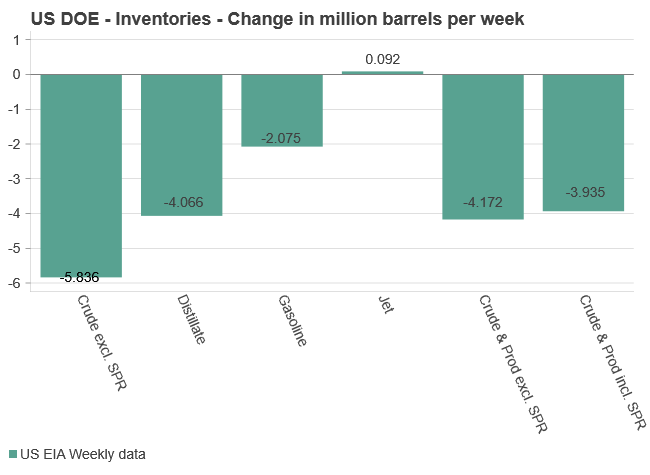Analys
OPEC poised to scrap Q4 production hike

As of mid-August, Brent crude oil has experienced a USD 5 per barrel (6.5%) increase in price since the low point on August 5th, currently trading at USD 80.3 per barrel, and remaining relatively unchanged from Monday’s opening.

As previously noted, the OPEC+ Joint Ministerial Monitoring Committee (JMMC) did not make any new recommendations at their meeting on August 1st. Specifically, a planned production increase of 2.2 million barrels per day is set to be gradually implemented from Q4 2024 through Q3 2025. However, despite this being the current OPEC base case, it is subject to significant uncertainties. If market conditions do not favor OPEC, the production increase may not materialize.
This week, the International Energy Agency (IEA) indicated that global oil markets could shift from a deficit to a surplus in Q4 2024 if OPEC+ proceeds with the aforementioned plan. This is not surprising and aligns with the consensus view; however, the plan is far from certain and should be taken with a grain of salt.
Global oil and product inventories have significantly depleted during peak summer demand. Yet, the recent drawdowns have been larger than expected: Yesterday, U.S. gasoline inventories decreased by 2.9 million barrels (3% below the five-year average), and distillate (diesel) inventories dropped by 1.7 million barrels (7% below the five-year average). Consequently, total commercial petroleum inventories decreased by 3.1 million barrels last week, which is counter-seasonal when compared with the 2015-2021 average.
As we exit the Northern hemisphere peak demand period, and assuming crude and product inventories stabilize according to seasonal patterns, a potential production increase from OPEC+ in October could lead to an oversupply.
Additionally, there is slowing demand growth in China, the world’s largest importer. Therefore, we believe that the OPEC+ plan, led by Saudi Arabia and Russia, to gradually increase production by 543,000 barrels per day in the fourth quarter will likely be adjusted or even scrapped. At present, there is no room for these additional volumes.
Brent crude continues to hover around USD 80 per barrel. A production increase from OPEC+ would likely cause prices to plummet to USD 60-70 per barrel overnight, which is well below the cartel’s ideal price range of USD 80-90 per barrel.
Furthermore, recent price volatility has increased due to conflicting factors. On one hand, relatively strong summer demand and heightened geopolitical tensions have pushed prices up, while on the other, weak economic growth in China has exerted downward pressure.
As a result, OPEC recently lowered its 2024 demand growth forecast due to weaker Chinese demand. However, it still projects growth rates more than double those estimated by the IEA, which expects global oil consumption to rise by about 1% annually, reaching 103.06 million barrels per day in 2024. This projection considers economic challenges and the ongoing shift to electric vehicles.
Another downside risk is the current positioning of managed money in petroleum futures, which suggests a bearish outlook, as highlighted by McGlone. A potential mean reversion in the stock market could be a critical factor when comparing crude oil to the S&P 500 Beta.
Petroleum speculators are nearing their most bearish stance, coinciding with the S&P 500 retreating from a 26% surge above its 100-week moving average in July (see pages 5-8 attached).
Historically, crude oil tends to decline when the S&P 500 Beta does. Over the past 25 years, the only instance where the S&P 500 maintained a level above a 26% premium to its mean for more than a few weeks was during the unprecedented monetary expansion in 2021, which may signal a forthcoming correction.
A continued and typical reversion in Beta could apply downward pressure on both WTI and Brent crude. Since 2011, petroleum speculators have averaged a 13% net-long position, with the lowest point being 4.4% in 2020.
This does not imply a negative outlook on the price curve. Our target for Brent crude is USD 85 per barrel in 2024. Year-to-date, the price has averaged USD 83.2 per barrel. Price distribution within a year typically varies by USD 15 per barrel from the mean. Therefore, we could see prices as high as USD 100 per barrel and as low as USD 70 per barrel. In very general terms, USD 70 per barrel could be seen at some point this year purely due to statistical fluctuations. This might occur in the coming weeks or months, as the latest market scare—though not a recession—resembles a correction that may still have more to play out. Additionally, ongoing uncertainty regarding the OPEC+ strategy continues to affect the market.
However, current market fundamentals suggest that OPEC+ is unlikely to increase production in the fourth quarter. Combined with increasing macroeconomic uncertainty, we remain confident in our Brent crude price direction and recommend continuing to buy at lower/mid USD 70 per barrel in the short term, reaffirming our positive outlook for Brent crude.
Analys
Tightening fundamentals – bullish inventories from DOE

The latest weekly report from the US DOE showed a substantial drawdown across key petroleum categories, adding more upside potential to the fundamental picture.

Commercial crude inventories (excl. SPR) fell by 5.8 million barrels, bringing total inventories down to 415.1 million barrels. Now sitting 11% below the five-year seasonal norm and placed in the lowest 2015-2022 range (see picture below).
Product inventories also tightened further last week. Gasoline inventories declined by 2.1 million barrels, with reductions seen in both finished gasoline and blending components. Current gasoline levels are about 3% below the five-year average for this time of year.
Among products, the most notable move came in diesel, where inventories dropped by almost 4.1 million barrels, deepening the deficit to around 20% below seasonal norms – continuing to underscore the persistent supply tightness in diesel markets.
The only area of inventory growth was in propane/propylene, which posted a significant 5.1-million-barrel build and now stands 9% above the five-year average.
Total commercial petroleum inventories (crude plus refined products) declined by 4.2 million barrels on the week, reinforcing the overall tightening of US crude and products.


Analys
Bombs to ”ceasefire” in hours – Brent below $70

A classic case of “buy the rumor, sell the news” played out in oil markets, as Brent crude has dropped sharply – down nearly USD 10 per barrel since yesterday evening – following Iran’s retaliatory strike on a U.S. air base in Qatar. The immediate reaction was: “That was it?” The strike followed a carefully calibrated, non-escalatory playbook, avoiding direct threats to energy infrastructure or disruption of shipping through the Strait of Hormuz – thus calming worst-case fears.

After Monday morning’s sharp spike to USD 81.4 per barrel, triggered by the U.S. bombing of Iranian nuclear facilities, oil prices drifted sideways in anticipation of a potential Iranian response. That response came with advance warning and caused limited physical damage. Early this morning, both the U.S. President and Iranian state media announced a ceasefire, effectively placing a lid on the immediate conflict risk – at least for now.
As a result, Brent crude has now fallen by a total of USD 12 from Monday’s peak, currently trading around USD 69 per barrel.
Looking beyond geopolitics, the market will now shift its focus to the upcoming OPEC+ meeting in early July. Saudi Arabia’s decision to increase output earlier this year – despite falling prices – has drawn renewed attention considering recent developments. Some suggest this was a response to U.S. pressure to offset potential Iranian supply losses.
However, consensus is that the move was driven more by internal OPEC+ dynamics. After years of curbing production to support prices, Riyadh had grown frustrated with quota-busting by several members (notably Kazakhstan). With Saudi Arabia cutting up to 2 million barrels per day – roughly 2% of global supply – returns were diminishing, and the risk of losing market share was rising. The production increase is widely seen as an effort to reassert leadership and restore discipline within the group.
That said, the FT recently stated that, the Saudis remain wary of past missteps. In 2018, Riyadh ramped up output at Trump’s request ahead of Iran sanctions, only to see prices collapse when the U.S. granted broad waivers – triggering oversupply. Officials have reportedly made it clear they don’t intend to repeat that mistake.
The recent visit by President Trump to Saudi Arabia, which included agreements on AI, defense, and nuclear cooperation, suggests a broader strategic alignment. This has fueled speculation about a quiet “pump-for-politics” deal behind recent production moves.
Looking ahead, oil prices have now retraced the entire rally sparked by the June 13 Israel–Iran escalation. This retreat provides more political and policy space for both the U.S. and Saudi Arabia. Specifically, it makes it easier for Riyadh to scale back its three recent production hikes of 411,000 barrels each, potentially returning to more moderate increases of 137,000 barrels for August and September.
In short: with no major loss of Iranian supply to the market, OPEC+ – led by Saudi Arabia – no longer needs to compensate for a disruption that hasn’t materialized, especially not to please the U.S. at the cost of its own market strategy. As the Saudis themselves have signaled, they are unlikely to repeat previous mistakes.
Conclusion: With Brent now in the high USD 60s, buying oil looks fundamentally justified. The geopolitical premium has deflated, but tensions between Israel and Iran remain unresolved – and the risk of missteps and renewed escalation still lingers. In fact, even this morning, reports have emerged of renewed missile fire despite the declared “truce.” The path forward may be calmer – but it is far from stable.
Analys
A muted price reaction. Market looks relaxed, but it is still on edge waiting for what Iran will do

Brent crossed the 80-line this morning but quickly fell back assigning limited probability for Iran choosing to close the Strait of Hormuz. Brent traded in a range of USD 70.56 – 79.04/b last week as the market fluctuated between ”Iran wants a deal” and ”US is about to attack Iran”. At the end of the week though, Donald Trump managed to convince markets (and probably also Iran) that he would make a decision within two weeks. I.e. no imminent attack. Previously when when he has talked about ”making a decision within two weeks” he has often ended up doing nothing in the end. The oil market relaxed as a result and the week ended at USD 77.01/b which is just USD 6/b above the year to date average of USD 71/b.

Brent jumped to USD 81.4/b this morning, the highest since mid-January, but then quickly fell back to a current price of USD 78.2/b which is only up 1.5% versus the close on Friday. As such the market is pricing a fairly low probability that Iran will actually close the Strait of Hormuz. Probably because it will hurt Iranian oil exports as well as the global oil market.
It was however all smoke and mirrors. Deception. The US attacked Iran on Saturday. The attack involved 125 warplanes, submarines and surface warships and 14 bunker buster bombs were dropped on Iranian nuclear sites including Fordow, Natanz and Isfahan. In response the Iranian Parliament voted in support of closing the Strait of Hormuz where some 17 mb of crude and products is transported to the global market every day plus significant volumes of LNG. This is however merely an advise to the Supreme leader Ayatollah Ali Khamenei and the Supreme National Security Council which sits with the final and actual decision.
No supply of oil is lost yet. It is about the risk of Iran closing the Strait of Hormuz or not. So far not a single drop of oil supply has been lost to the global market. The price at the moment is all about the assessed risk of loss of supply. Will Iran choose to choke of the Strait of Hormuz or not? That is the big question. It would be painful for US consumers, for Donald Trump’s voter base, for the global economy but also for Iran and its population which relies on oil exports and income from selling oil out of that Strait as well. As such it is not a no-brainer choice for Iran to close the Strait for oil exports. And looking at the il price this morning it is clear that the oil market doesn’t assign a very high probability of it happening. It is however probably well within the capability of Iran to close the Strait off with rockets, mines, air-drones and possibly sea-drones. Just look at how Ukraine has been able to control and damage the Russian Black Sea fleet.
What to do about the highly enriched uranium which has gone missing? While the US and Israel can celebrate their destruction of Iranian nuclear facilities they are also scratching their heads over what to do with the lost Iranian nuclear material. Iran had 408 kg of highly enriched uranium (IAEA). Almost weapons grade. Enough for some 10 nuclear warheads. It seems to have been transported out of Fordow before the attack this weekend.
The market is still on edge. USD 80-something/b seems sensible while we wait. The oil market reaction to this weekend’s events is very muted so far. The market is still on edge awaiting what Iran will do. Because Iran will do something. But what and when? An oil price of 80-something seems like a sensible level until something do happen.
-

 Nyheter3 veckor sedan
Nyheter3 veckor sedanStor uppsida i Lappland Guldprospekterings aktie enligt analys
-

 Nyheter4 veckor sedan
Nyheter4 veckor sedanBrookfield ska bygga ett AI-datacenter på hela 750 MW i Strängnäs
-

 Nyheter4 veckor sedan
Nyheter4 veckor sedanSommaren inleds med sol och varierande elpriser
-

 Nyheter4 veckor sedan
Nyheter4 veckor sedanOPEC+ ökar oljeproduktionen trots fallande priser
-

 Nyheter3 veckor sedan
Nyheter3 veckor sedanSilverpriset släpar efter guldets utveckling, har mer uppsida
-

 Analys4 veckor sedan
Analys4 veckor sedanBrent needs to fall to USD 58/b to make cheating unprofitable for Kazakhstan
-

 Nyheter4 veckor sedan
Nyheter4 veckor sedanTradingfirman XTX Markets bygger datacenter i finska Kajana för 1 miljard euro
-

 Nyheter2 veckor sedan
Nyheter2 veckor sedanUppgången i oljepriset planade ut under helgen









